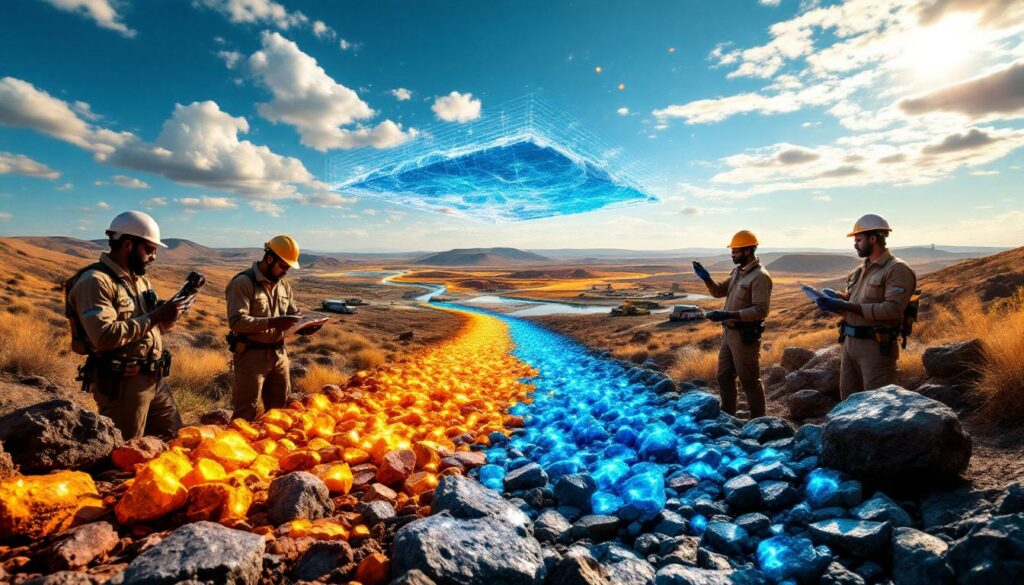India's Zambian Mineral Exploration: Strategic Push for Copper and Cobalt
India has launched a significant mineral exploration project in Zambia, sending a specialized team of geologists to search for copper and cobalt deposits. The Zambian government has allocated an extensive 9,000 square kilometers of land for this exploration effort, highlighting the scale and importance of this international mining collaboration. This three-year project represents India's strategic move to secure critical minerals transition essential for its energy transition and industrial development.
According to Mining Technology, the exploration team will conduct multiple field visits throughout the three-year timeline, with analysis primarily conducted in Indian laboratories. If viable deposits are discovered, India plans to request formal mining leases from the Zambian government.
Why Are Copper and Cobalt Critical for India's Future?
The Strategic Importance of These Minerals
Copper and cobalt represent crucial resources in India's industrial and technological development strategy. These minerals serve as fundamental components in:
- Energy Transition Infrastructure: Both minerals are essential for renewable energy systems, with copper serving as a primary conductor in solar panels, wind turbines, and energy transmission networks
- Electric Vehicle Production: Cobalt is a key component in lithium-ion batteries, with a typical EV battery requiring between 5-15kg of cobalt depending on the chemistry used
- Electronics Manufacturing: Copper's excellent conductivity makes it irreplaceable in electronics, from microchips to circuit boards
- Industrial Applications: Both minerals have widespread uses across multiple sectors including construction, manufacturing, and telecommunications
India's Growing Mineral Dependency
India's current mineral supply situation reveals significant vulnerabilities:
- Copper imports reached 1.2 million tonnes in the fiscal year ending March 2025, representing a critical dependency (Mining Technology, 2025)
- Cobalt oxide imports increased by 20% in 2024/25, demonstrating accelerating demand for battery materials
- The 2018 shutdown of Vedanta's Sterlite copper smelter significantly impacted domestic copper production, removing approximately 400,000 tonnes of annual capacity
- Growing competition with other nations for access to these critical resources has created supply chain pressures
"As India accelerates its renewable energy transition and EV manufacturing ambitions, securing stable supplies of copper and cobalt has become a national priority rather than simply an industrial concern." – Mining Technology, July 2025
How Will the Exploration Project Operate?
Project Structure and Timeline
The India-Zambia exploration initiative follows a carefully structured approach:
- Duration: Three-year comprehensive exploration program with phased implementation
- Methodology: Multiple field visits by Indian geological teams utilizing advanced surveying techniques
- Analysis Process: Primary analysis conducted in Indian laboratories with specialized mineral testing capabilities
- Area Coverage: Systematic exploration across the 9,000km² allocation, prioritizing areas with known geological similarities to productive mining regions
- Technical Approach: Employing advanced geological survey techniques including remote sensing, geochemical sampling, and drill results interpretation
The exploration process will likely involve initial wide-area surveys followed by increasingly focused examinations of promising sites. This approach maximizes efficiency when assessing large land areas while minimizing environmental disruption.
From Exploration to Production
The project roadmap extends beyond initial exploration:
- Upon identifying viable deposits, India plans to request formal mining leases from the Zambian government
- The government intends to invite private-sector companies to participate in development, bringing additional capital and expertise
- The project could establish a model for future India-Africa mineral partnerships based on mutual benefit
- Technical knowledge transfer may benefit Zambia's mining sector development, enhancing local capabilities
How Does This Fit Into India's Global Mineral Strategy?
Diversifying Mineral Supply Sources
India's Zambian initiative represents just one component of a broader global strategy:
- Active discussions with multiple African nations for mineral exploration opportunities
- Pursuing opportunities in Australia and Latin America for critical mineral access
- Specific engagement with the Democratic Republic of Congo for cobalt project expansion, targeting the world's richest cobalt reserves
- Strategic positioning to reduce dependency on dominant mineral suppliers through diversification
The Zambian project serves as a proof-of-concept for India's government-to-government approach to mineral security, potentially creating a template for similar arrangements with other resource-rich nations.
Reducing China Dependency
India's mineral strategy reveals clear efforts to decrease reliance on China:
- Instructed state-owned miner IREL to halt rare earth exports to Japan, demonstrating a willingness to reshape traditional supply relationships (Mining Technology, 2025)
- Developing alternative supply chains for critical minerals to reduce vulnerability to market manipulation
- Building strategic mineral reserves to buffer against market volatility and supply disruptions
- Investing in domestic processing capabilities to add value to raw materials and reduce dependence on foreign refineries
These moves reflect India's growing awareness that mineral security extends beyond mere access to raw materials—it requires control of the entire value chain from exploration to processing.
What Are the Potential Benefits for Both Nations?
Advantages for India
The Zambian exploration project offers India multiple strategic benefits:
- Securing direct access to critical mineral supplies essential for industrial development
- Reducing vulnerability to market fluctuations and supply constraints through diversified sourcing
- Establishing stronger economic ties with resource-rich African nations, creating diplomatic leverage
- Supporting domestic manufacturing and energy transition goals through stable mineral access
- Building technical expertise in international mining operations that can be applied to future projects
From an economic perspective, direct access to these minerals could significantly reduce India's import expenditures, which have been rising annually as domestic demand increases.
Advantages for Zambia
Zambia stands to gain significantly from this partnership:
- Foreign investment in mineral exploration and potential development without immediate capital requirements
- Technical knowledge transfer from Indian geological expertise, enhancing local capabilities
- Diversification of international mining partners beyond traditional investors
- Potential for downstream processing and value addition within Zambia's borders
- Strengthened diplomatic and economic ties with India, opening doors to additional cooperation
For Zambia, which has historically relied heavily on copper exports, this partnership could help modernize its mining sector while creating new economic opportunities beyond raw material extraction.
What Challenges Could Impact the Project's Success?
Technical and Operational Hurdles
Several factors could influence exploration outcomes:
- Geological complexity and deposit accessibility in unexplored regions
- Infrastructure limitations in remote exploration areas, including transportation and power access
- Technical challenges in accurate resource estimation and quality assessment
- Environmental considerations in sensitive ecosystems requiring careful management
- Logistical complexities of international operations spanning multiple continents
Successful exploration requires overcoming these challenges through careful planning, adequate resource allocation, and technical expertise from both countries.
Geopolitical and Economic Considerations
Broader contextual factors may impact the project:
- Changing global mineral market conditions affecting economic viability
- Competition from other nations seeking similar resources in the region
- Regulatory and policy shifts in either country that could alter project parameters
- Geopolitical tensions affecting international cooperation and trade relationships
- Economic viability based on discovery size and quality relative to development costs
"International mineral partnerships increasingly exist at the intersection of geopolitics and economics, with successful projects requiring alignment of both technical feasibility and strategic interests." – Mining Technology, July 2025
How Does This Project Compare to Other International Mining Ventures?
Similar International Mineral Partnerships
India's Zambian exploration can be contextualized alongside other international mining initiatives:
- China's extensive mineral investments across Africa, particularly in the Democratic Republic of Congo, where Chinese companies control approximately 70% of cobalt mining
- Australia's partnerships with various nations for critical minerals, emphasizing responsible sourcing
- European efforts to secure battery mineral supply chains through strategic partnerships and investments
- Japan's strategic mineral agreements in Southeast Asia focused on rare earths and base metals
- Canada's international mining presence in developing regions, often incorporating sustainability standards
The global race for mineral resources has intensified as energy transition technologies drive demand for specific minerals, creating both competition and opportunities for new partnerships.
Unique Aspects of the India-Zambia Partnership
Several factors distinguish this particular exploration project:
- Focus on specific minerals critical to energy transition rather than general resource exploration
- Government-to-government structure rather than purely commercial arrangement, potentially allowing for more comprehensive cooperation
- Laboratory analysis conducted primarily in India, creating a direct knowledge transfer to Indian institutions
- Potential model for future South-South cooperation in resource development beyond traditional North-South investment patterns
- Strategic alignment with both countries' development goals, creating mutual benefits beyond immediate economic returns
This approach contrasts with China's model in Africa, which often involves state-backed companies operating with commercial objectives, sometimes raising concerns about resource extraction without adequate local benefits.
FAQ: India's Mineral Exploration in Zambia
What specific minerals is India seeking in Zambia?
India is primarily exploring for copper and cobalt deposits, both critical for energy transition technologies and industrial applications.
How long will the exploration project last?
The project is scheduled to continue for three years, with multiple field visits planned throughout this period.
Will private companies be involved in the project?
While the exploration is government-led, India plans to invite private-sector companies to participate if viable deposits are discovered.
How much land has been allocated for exploration?
The Zambian government has provided India with access to 9,000 square kilometers for mineral exploration activities.
Where will the mineral analysis take place?
According to project specifications, the primary analysis of geological samples will be conducted in Indian laboratories.
Future Outlook for India-Africa Mineral Cooperation
The India-Zambia exploration project potentially signals a new chapter in India-Africa resource partnerships. As global competition for copper investment strategies intensifies, these collaborative approaches may become increasingly common. The success of this initiative could establish a template for similar arrangements across the continent, potentially reshaping traditional mineral supply dynamics and creating more diversified global resource networks.
For both India and Zambia, the project represents an opportunity to advance mutual interests while addressing critical resource needs. As exploration progresses, the findings will not only determine the commercial viability of mining operations but also influence broader strategic relationships between India and mineral-rich African nations.
This partnership aligns with the objectives of the Africa Mining Vision (AMV), which emphasizes value addition, economic diversification, and sustainable development through mineral resource exploitation. If successful, it could demonstrate how international cooperation can support these goals while meeting the needs of rapidly developing economies.
Disclaimer: This article contains forward-looking statements about mineral exploration outcomes and international partnerships. Actual results may vary significantly based on geological findings, market conditions, and geopolitical developments. Readers should consider these factors when evaluating the potential impact of this exploration project.
Ready to Catch the Next Major Mineral Discovery?
Stay ahead of the market with real-time alerts on significant ASX mineral discoveries through Discovery Alert's proprietary Discovery IQ model, transforming complex mineral data into actionable insights for both short-term traders and long-term investors. Learn why historic discoveries can generate substantial returns by visiting Discovery Alert's dedicated discoveries page and begin your 30-day free trial today.




